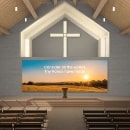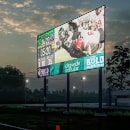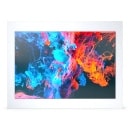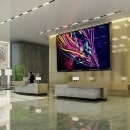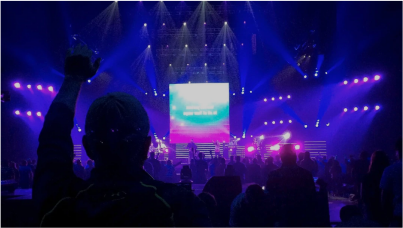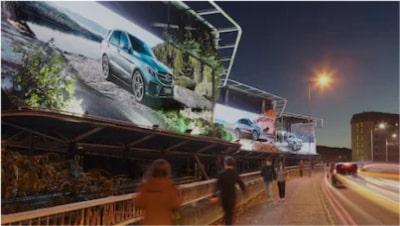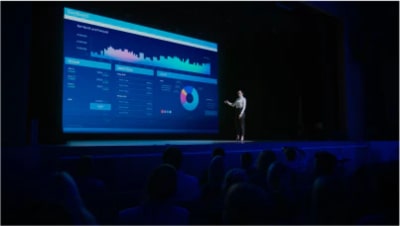What Are the Big Screens at Concerts Called?
Picture this: you’re at a concert featuring your favorite band, and though the music is sensational, you're stationed far away from the stage. You might've faced a dilemma of squinting or resigning to merely listen. But then you glance upwards and find a massive screen displaying close-ups of the performers, their expressions, and every detail of the show in crystal clear quality.
This screen, as mammoth and magnanimous as it is, has a name. It's the bridge between you and the action, the technological marvel that ensures everyone, irrespective of their ticket, gets a front-row experience. At Ultravision LED Solutions, we've been at the forefront of this transformative technology, and today, we'll unravel the magic behind these colossal displays.
Big Screens at Concerts are Called Jumbotrons
The origin of the term "Jumbotron"
The term "Jumbotron" finds its roots in the 1980s when it was trademarked by Sony, a blend of "jumbo" and the "tron" from electronics. The original purpose was to provide large-scale, high-definition visuals at sporting events, ensuring every attendee, regardless of their seat location, had an optimal viewing experience.
Though many might assume it's a generic name for big screens at events, it's actually specific to Sony's product. However, as with several brand names that become ubiquitous with the product itself, "Jumbotron" began to be used colloquially to refer to large LED screens in various venues.
How the Jumbotron revolutionized live events and concerts
Before the Jumbotron's arrival, attending a live event meant you were often at the mercy of your seat placement. Those stationed in the nosebleed sections might have found it difficult to see the performers or the action on the field. Enter the Jumbotron, and suddenly, everyone had a clear, enlarged view.
Concerts became more inclusive, ensuring that even attendees in the farthest rows could see their favorite artist's expressions and movements. Not just a tool for better visibility, Jumbotrons transformed the very nature of events. They allowed for instant replays at sports games, added depth to musical performances with creative visuals, and even facilitated interaction with the audience through live camera feeds.
With Jumbotrons, events became more than just a distant stage performance; they evolved into full-fledged multimedia experiences. The screens' ability to display high-quality video in real-time meant that they could supplement the live action, offering different angles, close-ups, and behind-the-scenes content.
For us at Ultravision LED Solutions, understanding this evolution was key. We recognized early on that to cater to an increasingly tech-savvy audience, integrating state-of-the-art display technology would be essential. And so, our journey began, paralleling the rise and impact of the Jumbotron in transforming live events.
Discover our large LED screens for concerts here.
Technical Aspects: What Makes a Jumbotron Tick?
Pixel density and why it matters.
When you're staring up at a giant screen, the last thing you want is a blurry or pixelated image. That's where pixel density comes into play. Pixel density refers to the number of pixels in a given area of the screen. Higher pixel density equates to crisper and clearer visuals, which is paramount for large-scale displays like Jumbotrons.
Imagine being at a concert or a sporting event and the displayed replay or the artist's close-up appears grainy or unclear. The entire purpose of the screen would be defeated. That's why ensuring optimal pixel density is crucial for delivering a seamless viewing experience.
The technology behind LED display screens
LED, which stands for Light Emitting Diode, is the technology that powers these massive screens. Unlike traditional bulbs, LEDs produce light when electricity passes through them, resulting in more vibrant and dynamic color displays. LEDs are energy-efficient, have a longer lifespan, and can produce richer colors compared to older display technologies.
The true power of LED technology is its scalability. While it's the same basic technology used in your home's TV or computer monitor, on a Jumbotron, it's taken to an entirely different scale. Large LED screens comprise thousands, sometimes millions, of tiny LEDs. Each LED acts as a pixel, and together they form the images and videos you see on the screen.
Jumbotrons also employ a matrix system wherein each pixel is defined by red, green, and blue LEDs (RGB). By adjusting the brightness of each colored LED within a pixel, an array of colors can be produced, which together form the vivid and lifelike images synonymous with Jumbotrons. This technology ensures that visuals are not only large but also lifelike, making the viewer feel closer to the action.
Types of Jumbotrons: One Size Doesn’t Fit All
Indoor vs. outdoor displays: Differences and considerations
Jumbotrons aren't a monolithic entity. They adapt and vary based on where they're installed – be it a cozy indoor concert hall or a sprawling outdoor stadium. Indoor Jumbotrons typically have higher pixel densities, given that viewers are generally closer to the screen. Brightness levels can be more controlled, as they don't have to compete with natural light, leading to richer visuals. These screens are also shielded from the elements, allowing for sleeker designs without the need for protective casings.
Outdoor Jumbotrons, conversely, have their own set of challenges and requisites. They must be bright enough to remain clear even under direct sunlight. Durability is paramount; they need to withstand varying weather conditions, from rain to wind to extreme temperatures. Protection against dust and moisture penetration is vital to ensure longevity and consistent performance. The screens are often larger to cater to more expansive audiences.
Sizes and customizability: From small stages to mega-events
Jumbotrons aren't just about going big; they're about fitting the right screen to the right venue. They come in various sizes, from those suitable for smaller indoor venues to colossal screens apt for mega-events. And with the advancement in technology, modular designs have become increasingly prevalent. This means individual LED panels can be pieced together, allowing for tremendous flexibility in terms of screen dimensions and configurations.
When hosting an event, one must consider the venue size, audience number, and viewing angles to determine the most suitable Jumbotron size. After all, an overly large screen in a compact space might overwhelm the viewers, while a screen too small in a vast area might render itself ineffective.
Special features and enhancements: Interactive capabilities, AR integrations, etc.
Modern Jumbotrons are not just passive display units. They've evolved into interactive platforms, offering functionalities beyond just video display. Some are equipped with touch-responsive features, allowing audiences to interact with displayed content. Others might integrate Augmented Reality (AR) elements, blurring the lines between the physical and digital realms and offering an enriched multimedia experience.
These advancements open a plethora of opportunities for event organizers. Imagine a concert where attendees can vote for the next song via the Jumbotron or a product launch where viewers can interact with a 3D model of the product.
Beyond Concerts: The Versatility of Jumbotrons
Use in sports: Digital scoreboards and replay screens.
Step into any modern sports arena, and you'll be hard-pressed to miss the colossal Jumbotron, often suspended at the center or installed prominently at either end. While concerts have indeed benefited immensely from Jumbotron technology, it's the sporting world that truly showcases its versatility. Digital scoreboards display live scores, player stats, and other critical game data in real-time. Fans no longer strain their eyes on old-school manual scoreboards; they're presented with dynamic, colorful, and often animated updates that bring the game closer than ever.
Replay screens, a subset of Jumbotrons in these arenas, are an absolute game-changer. Critical moments, controversial decisions, spectacular goals, or edge-of-the-seat action can be replayed almost instantly. This feature not only enhances the viewing experience but also aids referees and officials in making more informed decisions.
Digital billboards: Making advertisements larger than life.
Take a drive through Times Square in New York or the Las Vegas Strip, and you'll be greeted with a visual spectacle of digital billboards. These are essentially Jumbotrons, repurposed for advertising. They make advertisements pop, drawing eyes and making messages impossible to ignore. Their dynamic nature means advertisers can display multiple messages, incorporate videos, and even make real-time updates.
Corporate events: Showcasing product launches, keynote speeches, or company updates
Corporate events might not have the fanfare of concerts or the excitement of sports matches, but the importance of clear, effective communication here cannot be understated. Jumbotrons play a pivotal role, whether it's showcasing a new product, broadcasting keynote speeches to larger audiences, or sharing company updates.
A product launch, for example, can use the Jumbotron to display the product in intricate detail, offering attendees a close-up view irrespective of their seating position. Keynote speeches, often the highlight of corporate events, benefit from enlarged visuals, ensuring every data point, slide, or video clip is clearly visible to all.
The Role of Jumbotrons in Enhancing Audience Experience
Immersive experiences: Why bigger is sometimes better.
The drive for an immersive audience experience has been at the forefront of entertainment and event innovations. The rationale is simple; the more engaged an audience is, the more memorable the event becomes. A significant player in creating this immersion is the Jumbotron. These colossal screens do more than just display content; they encapsulate it, enlarging every emotion, amplifying every detail, and drawing the audience into the heart of the action.
Imagine the impact of a pivotal movie scene, where emotions run high, and every facial expression tells a story. On a standard screen, this impact is limited. But when amplified on a Jumbotron, the scene becomes all-consuming, capturing the audience in a cocoon of sight and sound, making them feel every tremor of emotion.
Enhancing visibility: No more 'bad seats'.
One of the long-standing issues in large event venues, be it stadiums, concert halls, or conference centers, is the existence of 'bad seats' – places from where the stage seems distant, or the view is partially obscured. Enter Jumbotrons. These screens have been instrumental in democratizing the viewing experience. With crisp visuals projected on large screens, every seat becomes a good one.
The advantages extend beyond mere visibility. It means that attendees, irrespective of their location in the venue, get the same quality of experience. Everyone sees the same level of detail, the same colors, the same vibrancy. This uniformity ensures that the message, whether it's a singer's performance, a speaker's presentation, or a brand's advertisement, is consistently received by all.
Synchronization with other media elements: Lights, sound, and visuals.
While Jumbotrons themselves are a marvel, their true power is unleashed when they work in tandem with other media elements. A concert, for instance, isn't just about the video visuals; it's a symphony of lights, sound, and screen. When the flashing lights sync with the beat, the visuals on the Jumbotron correspond with the performance, and the sound quality is pitch-perfect, the result is an unparalleled multisensory experience.
The Cost Aspect: Is Investing in a Jumbotron Worth It?
ROI considerations for event organizers and advertisers.
Discussing the return on investment (ROI) of Jumbotrons is indispensable when considering the tangible benefits they bring to events and advertising campaigns. For event organizers, the enhanced audience engagement directly translates to more successful events – whether that success is measured in ticket sales, audience feedback, or future sponsorships. An engaged audience is more likely to share their positive experiences, indirectly leading to heightened brand awareness and loyalty for the organizers.
For advertisers, the sheer size and visibility of a Jumbotron make ads hard to ignore. It's one thing to see an advertisement on a regular screen, and entirely another to see it magnified, capturing the attention of a massive audience. The increased visibility often results in improved brand recall and a higher likelihood of audience conversion. When you pair this impact with the relatively short duration of most advertisements, the cost-per-impression becomes highly competitive, especially in high footfall areas or during prime events.
Maintenance, durability, and lifespan of LED screens.
The allure of Jumbotrons isn't limited to their impressive display capabilities. One of their standout features is their durability and longevity. These screens are crafted to withstand various environmental conditions, especially the outdoor models. Rain, dust, intense sunlight – a quality Jumbotron is resilient in the face of these challenges. This robustness ensures a reduced need for frequent maintenance, translating to cost savings in the long run.
Furthermore, the lifespan of LED screens, if maintained properly, is impressive. They can last for years without significant degradation in quality. This longevity means that the initial investment in a Jumbotron is spread over many years, reducing the annual cost implication.
Comparing costs: Renting vs. buying.
When approaching the cost of a jumbotron, the decision between renting and buying a Jumbotron is contingent on several factors, including frequency of use, budget constraints, and long-term requirements. Renting can be an attractive option for one-off events or for those who want to test the waters before committing. It offers the advantage of lower upfront costs and the flexibility to choose different screen sizes or models for various events.
On the other hand, buying is a long-term investment. For organizations hosting regular events or those using the screen as a permanent fixture, purchasing can be more economical in the long run. Owning a Jumbotron also allows for complete customization and control over the content, without the constraints that might come with rental agreements.
Ultravision LED Solutions: A Pioneer in Jumbotron Technology
Founded with a vision to revolutionize the LED industry, Ultravision LED Solutions has been at the forefront of delivering innovative LED display solutions to our esteemed clients. From the bustling streets of Times Square to the massive arenas hosting global events, our touch is evident in the illuminated experiences our products provide.
We are more than just an LED company; we're a collective of passionate professionals, committed to enhancing visual communications in urban spaces, arenas, and beyond. Our ethos is simple – provide unparalleled quality, drive continuous innovation, and offer unwavering support to our clients.
We Invented the Modular LED Display Panel Used in Jumbotrons
Taking pride in our pioneering spirit, we at Ultravision LED Solutions developed the Modular LED Display Panel that forms the core of modern Jumbotrons. This invention streamlined the installation process, reduced maintenance complexities, and ensured that massive screens could deliver impeccable visual quality consistently. Our ingenuity in this space has paved the way for many, but our original design remains unmatched in its brilliance and functionality.
Superior Display Quality, Longevity, and Durability
One of the cornerstones of our reputation is the superior display quality our LED panels offer. Vibrant colors, sharp contrasts, and a display that remains unaffected by glaring sunlight or inclement weather conditions - these are but a few of the hallmarks of an Ultravision product.
Furthermore, our screens are built to last. With rigorous quality checks and a design centered on durability, our Jumbotrons offer longevity that’s hard to rival. This long operational life ensures that our clients realize optimal value from their investment.
Full Support in Design, Permits, Software & Installation
Venturing into the world of large-scale LED displays can be daunting for many. Recognizing this, we extend comprehensive support to our clients, starting from the design phase, right up to installation and beyond. Our team assists with permit acquisitions, ensuring that the screens are in full compliance with local regulations. We also provide software solutions tailored to the unique needs of every project. And, of course, our installation experts ensure that the setup process is seamless and efficient.
Choosing Ultravision LED Solutions is more than just a purchase decision; it’s an investment in a partnership. We remain committed to our clients’ visions, providing support every step of the way, ensuring that their LED aspirations translate to luminous realities.
Discover our products and services today: https://ultravisionledsolutions.com/
